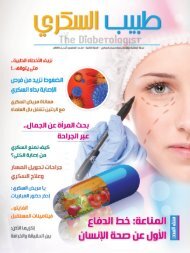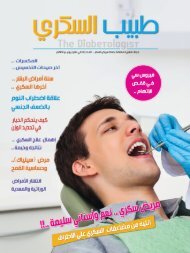The Diabetologist #24+25
طبيب السكري - العدد 24+25
طبيب السكري - العدد 24+25
Create successful ePaper yourself
Turn your PDF publications into a flip-book with our unique Google optimized e-Paper software.
ADDITIONAL CONSIDERATIONS<br />
Disordered Eating Behaviors, Eating Disorders,<br />
and Other Age-Related Concerns<br />
Body image and weight-management issues in T1D<br />
adolescents and young adults with T1D may lead<br />
to eating disorders and disordered eating behaviors<br />
(see chapter 8, Psychosocial Issues in Type 1 Diabetes).<br />
It is unclear if there is an increased prevalence<br />
of diagnosable eating disorders and disordered<br />
eating behaviors in T1D patients compared<br />
with the general population. Some studies show a<br />
higher rate in T1D patients, while others have found<br />
the same or lower rates.78 Estimates in T1D adolescent<br />
and young adult females range from 3.8 to<br />
27.5% for patients classified as bulimic or having<br />
binge eating disorder. When insulin omission is considered<br />
purging, the estimate is as high as 38-40%.<br />
<strong>The</strong> presence of eating disorders has been associated<br />
with increases in retinopathy, neuropathy, transient<br />
lipid abnormalities, hospitalizations for diabetic<br />
ketoacidosis, and poor short-term metabolic control.<br />
Adolescents with diabetes should be screened<br />
regularly for signs of potential eating issues and concerns<br />
with weight and body image as well as insulin<br />
omission. After screening, issues can be addressed<br />
and action can be taken to prevent the development<br />
of an eating disorder, which is very complicated to<br />
treat especially when it coexists with T1D. Warning<br />
signs that suggest an eating disorder in adolescents<br />
include inadequate weight gain or growth, significant<br />
weight loss without illness, suboptimal overall<br />
glycemic control, and recurrent diabetic ketoacidosis.<br />
If signs of disordered eating and weight or body<br />
image concerns are present, they need to be addressed;<br />
referral to a dietitian and psychotherapist<br />
or psychologist is recommended. If a patient is at<br />
high risk of an eating disorder, the patient should<br />
be referred to an eating disorder program for an assessment<br />
and treatment, if necessary.10<br />
Finally, adolescents with diabetes may experiment<br />
with alternative eating patterns, such as vegetarianism<br />
or nutritional supplement use. Practical information<br />
on these topics will enable adolescents to make<br />
wise choices for their health.10<br />
NUTRITION THERAPY FOR CELIAC<br />
DISEASE AND T1D<br />
Celiac disease (CD) is an important entity to consider<br />
since those with T1D are also at increased risk<br />
for developing CD. Individuals diagnosed with both<br />
CD and T1D should seek the care of an RD familiar<br />
with the nutritional management of both entities.<br />
<strong>The</strong> RD should also provide comprehensive support<br />
and education about gluten-free diets (GFD).<br />
<strong>The</strong> Gluten-Free Diet<br />
Since nutritional deficiencies have been reported<br />
with long-term GFD, comprehensive nutrition assessments<br />
must be done to ensure adequate nutrient<br />
intake.79,80 A GFD can be extremely challenging,<br />
since ongoing monitoring of ingredients in foods<br />
and food processing are intricate parts of nutrition<br />
interventions.81<br />
For newly diagnosed children and adults with CD,<br />
studies report that adherence to a gluten-free eating<br />
pattern results in significant improvements in serum<br />
Hb, iron, zinc, and calcium, as a result of intestinal<br />
healing and improved absorption. However, adherence<br />
to the gluten-free eating pattern may result in a<br />
diet that is high in fat and low in carbohydrates, fiber,<br />
iron, folate, niacin, vitamin B12, calcium, phosphorus,<br />
and zinc. A small number of adult studies show<br />
a trend toward weight gain after diagnosis.81,82<br />
Several studies report that patients with CD (treated<br />
and untreated) are more likely to experience gastrointestinal<br />
symptoms such as diarrhea, constipation,<br />
abdominal pain and bloating, nausea or vomiting,<br />
reduced gut motility, and delayed gastric emptying<br />
than healthy control subjects. However, long-term<br />
adherence to a GFD has been shown to reduce the<br />
prevalence of these symptoms.81,82<br />
Implementing the Gluten-Free Diet<br />
A GFD can be more expensive than a normal diet<br />
and requires extensive, repeated counseling and<br />
RD instruction. Patients with CD must be meticulous<br />
label readers and knowledgeable about food<br />
processing, preparation, and handling practices to<br />
avoid cross-contamination with gluten-containing<br />
grains. As little as 10 mg gluten (1/50th a slice of<br />
bread) can cause significant mucosal inflammation in<br />
some individuals. <strong>The</strong>refore, it is recommended that<br />
contaminating gluten should be kept to

















